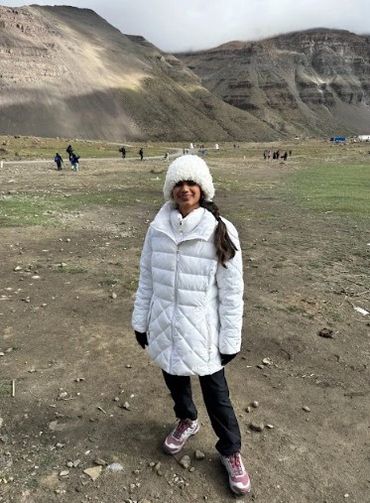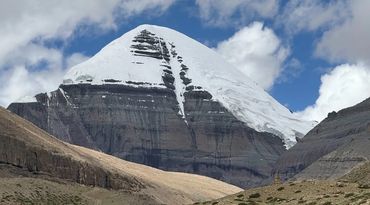A sacred journey to the roof of the world—where spirit, strength, and silence met at Mount Kailash.
June 2025
On This Page

- About my Mt. Kailash Hike and Journey
- Why is it revered and a challenge?
- Hurdles before the Trip
- Prep and Groundwork
- Day 1, 2, and 3 - Info and videos
- Mana Sarovar- The Holy Lake
- Pictures
- Lake Manasarovar
- Reference- Full Trip Itinerary via Nepal
My Journey to Mt. Kailash
In June 2025, I embarked on one of the most meaningful and challenging journeys of my life—a spiritual and physical pilgrimage to Mount Kailash in Tibet. Revered across Hindu, Buddhist, Jain, and Bon traditions, Kailash is not just a mountain—it’s a symbol of transcendence, transformation, and inner stillness. Preparing for this hike was more than logistics; it was a test of resilience, faith, and my deep love for nature.

The Importance and Challenge of the Parikrama
The Kailash Parikrama is considered one of the most spiritually fulfilling pilgrimages in the world because it offers a rare opportunity to walk around a mountain revered as the cosmic center by Hindus, Buddhists, Jains, and Bon followers. Believed to be the abode of Lord Shiva and a gateway to liberation (moksha), the 52-kilometer trek is seen as a path to inner purification and divine connection.
But this sacred journey is also a formidable challenge—trekkers face extreme altitudes of up to 18,500 feet, thin oxygen, unpredictable weather, and rugged terrain. The physical hardship becomes part of the spiritual experience, demanding surrender, resilience, and deep reflection with every step. For many, the difficulty is what makes the transformation so profound.
The Kailash Parikrama—also known as the Kailash Kora—is a sacred trek that circles Mount Kailash. Rather than climbing the mountain (which is strictly forbidden), pilgrims walk around it in a clockwise direction as an act of devotion, purification, and surrender.
The Parikrama typically takes three days and involves crossing Dolma La Pass, which reaches an altitude of 5,650 meters (18,500 feet)—making it one of the highest and most challenging pilgrimages in the world. The journey begins at Yamdwar, symbolizing the gateway between life and death, and passes through sacred sites like Derapuk, and Zuthulpuk, each offering moments of reflection and spiritual connection.
For many, the Parikrama is believed to cleanse karma, release past burdens, and bring moksha (liberation). It’s not just a trek—it’s a transformative experience where every step becomes a prayer.

Hurdles Before The Trip

Towards the end of March 2025, just a couple of months before departure, I fractured my foot—leaving me with barely any time to train. It was a tough blow, both physically and emotionally. But I was determined not to give up. With the help of my doctors and a lot of patience, I focused on healing and slowly rebuilding strength.
Prep and Groundwork
Preparing for the Mount Kailash trek was a journey in itself—equal parts physical training, mental focus, and logistical planning. I started with cardio workouts at the gym, especially the Stairmaster to simulate elevation gain, and added strength training to build endurance. To get a feel for real terrain, I hiked locally at Valley Forge and Mount Tammany in New Jersey. I researched weather patterns, altitude effects, and breathing techniques, incorporating Pranayama into my daily routine to improve lung capacity. Packing was strategic: three layers of clothing for temperature shifts, hiking poles for stability, waterproof shoes, thermals, energy bars, and Gatorade powder to stay fueled and hydrated. Every step of preparation was a reminder that this wasn’t just a trek—it was a test of resilience and readiness for something sacred..
Local Trek- Mt. Tammany Trail, NJ
Geography and Weather Analysis
My research showed me that trekking around Mount Kailash means entering one of the most extreme environments on Earth. The Kailash Parikrama route averages over 5,000 meters (16,400 feet) in elevation, with the highest point—Dolma La Pass—reaching 5,650 meters (18,500 feet). At this altitude, oxygen levels drop to nearly 50% of sea level, making every breath feel shallower and physical exertion significantly harder. The thin air can cause altitude sickness, especially if the body hasn’t acclimatized properly. Weather conditions are equally intense: even in summer, temperatures can dip below freezing, and sudden wind gusts or snow flurries are common. The dry air and high UV exposure also increase the risk of dehydration and sunburn. Trekking here isn’t just a physical challenge—it’s a test of how well you’ve prepared your body, mind, and gear for the high-altitude wilderness.



🏔️ Kailash Parikrama: My Hike Diary
Day 1 - Where the sacred journey begins
📍 Day 1 – Yamdwar to Derapuk
Distance: 16 km Altitude: ~4,900 m (16,000 ft)
We began at Yamdwar, the gateway between the physical and spiritual realms. The air was thin, and every breath reminded me of the altitude. As we walked across the vast openness of the Tibetan plateau, I found myself surrounded by fellow pilgrims—some quiet, some chanting, all deeply focused. Toward the end of the day, the north face of Mount Kailash slowly emerged, majestic and silent. We stayed at a guest house directly beneath the mountain, where I spent the evening meditating under the stars, feeling both grounded and elevated.
⛰️ Day 2 – Where breath fades and spirit rises
⛰️ Day 2 – Derapuk to Zuthulpuk via Dolma La Pas
Distance: 22 km Altitude: Up to 5,650 m (18,500 ft)
This was the most demanding day. The steep climb to Dolma La Pass tested every part of me—physically and mentally. The oxygen was scarce, the wind sharp, and the terrain unforgiving. But reaching the top was deeply emotional: prayer flags fluttered, offerings lay scattered, and the silence was sacred. The descent to Zuthulpuk was gentler, with flat stretches and endless sky. The openness of the land gave me time to reflect, and the companionship of other trekkers made the journey feel shared yet personal.
🚶♀️ Day 3 – The final stretch
🚶♀️ Day 3 – Zuthulpuk to Darchen
Distance: ~4 hours of walking
The last leg was a quiet walk to the bus pickup point, followed by a short drive to Darchen. The terrain was mostly flat, and the morning light cast long shadows across the valley. I felt a mix of relief and longing—grateful for the experience, but not quite ready to leave. The Kailash Parikrama was complete, but its impact will stay with me forever.
Mana Sarovar- The Holy Lake
En Route to Mt. Kailash
Lake Manasarovar, located near Mount Kailash and en route to the sacred mountain, holds immense spiritual significance as one of the holiest freshwater lakes in the world. Believed to be created by Lord Brahma’s mind and recognized as a Shakti Peeth where the hands of Goddess Sati are said to have fallen, the lake is a powerful place of purification and reflection. Before beginning the Kailash Parikrama, I visited the tranquil banks of Manasarovar, where I meditated in the serene stillness, surrounded by the gentle presence of swans and the vast sky—an experience that grounded me deeply and prepared my spirit for the challenging journey ahead.

Mana Sarovar Pictures



Captured Memories
















Reference - Full Trip Itinerary - Via Nepal

🗺️ Mount Kailash Yatra – June–July 2025
Route: Nepal → Tibet → Mount Kailash Parikrama
Duration: ~13 days
✈️ Day 1 – June 22 (Sunday)
Arrival: Tribhuvan International Airport, Kathmandu
- Altitude: 1,324 m
- Activities: Immigration, baggage claim, currency exchange (Nepali Rupees)
- Stay: Radisson Hotel, Kathmandu (7 km from airport)
- Notes: Handed over passport to guide; met group members
🛕 Day 2 – June 23 (Monday)
Kathmandu City Tour
- Temples visited:
- Pashupatinath (bring Indian ID; no leather or photography)
- Guhyeshwari Shakti Peeth
- Budhanilkantha Vishnu Temple
- Swayambhunath Stupa
- Activities: Spiritual sightseeing, local travel (~30 km round trip)
- Stay: Radisson Hotel, Kathmandu
🏙️ Day 3 – June 24 (Tuesday)
Bhaktapur Excursion
- Sites visited:
- Kailashnath Mahadev Statue (tallest Shiva statue)
- Doleshwar Mahadev (linked to Kedarnath legend)
- Bhaktapur Durbar Square
- Activities: Cultural exploration, spiritual connection
- Stay: Radisson Hotel, Kathmandu
🚐 Day 4 – June 25 (Wednesday)
Drive to Timure Village
- Distance: 123 km (~6 hours)
- Altitude: 1,850 m
- Activities: Scenic drive, river views
- Stay: River View Resort, Timure
🌉 Day 5 – June 26 (Thursday)
Cross into Tibet via Friendship Bridge
- Immigration at Gyirong Port
- Drive to Kerung (Gyirong) – 24 km (~1 hour)
- Activities: Border crossing, acclimatization
- Stay: Pilgrimage Inn Hotel, Kerung
🏞️ Day 6 & 7 – June 27–28 (Friday–Saturday)
Drive to Saga
- Distance: 230 km (~5 hours)
- Altitude: ~4,500 m
- Activities: Acclimatization, rest
- Stay: Station Manor Hotel, Saga
🌊 Day 8 – June 29 (Sunday)
Drive to Lake Manasarovar
- Distance: 450 km (~7–11 hours)
- Altitude: ~4,580 m
- Activities: Visit sacred lake, chant “Aum,” view Rakshastal
- Stay: Guesthouse near Manasarovar
🏔️ Day 9 – June 30 (Monday)
Drive to Darchen
- Distance: 40 km (~30 mins)
- Activities: Circumambulation of Manasarovar, prep for trek
- Stay: Himalayan Kailash Hotel, Darchen
🥾 Kailash Parikrama – 3-Day Trek
🗓️ Day 10 – July 1 (Tuesday)
Yamdwar to Derapuk
- Distance: 16 km
- Altitude: ~4,900 m
- Activities: Begin trek, view Kailash’s north face, meditate
- Stay: Guesthouse at Derapuk
🗓️ Day 11 – July 2 (Wednesday)
Derapuk to Zuthulpuk via Dolma La Pass
- Distance: 22 km
- Altitude: Up to 5,650 m
- Activities: Steep climb, spiritual offerings, descent
- Stay: Guesthouse at Zuthulpuk
🗓️ Day 12 – July 3 (Thursday)
Zuthulpuk to Darchen
- Distance: ~4 hours walk
- Activities: Final stretch, bus pickup, return to base
- Stay: Himalayan Kailash Hotel, Darchen
🛫 Day 13 – July 4 (Friday)
Return Journey Begins
- Activities: Travel back through Tibet and Nepal
- Reflections: Journey complete, spiritual fulfillment
This website uses cookies.
We use cookies to analyze website traffic and optimize your website experience. By accepting our use of cookies, your data will be aggregated with all other user data.